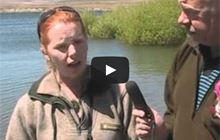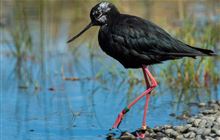Australasian crested grebe / kāmana / pūteketeke
Introduction
The Australasian crested grebe or pūteketeke is a diving water bird. Lake Pearson/Moana Rua in Canterbury has been designated a wildlife refuge to help protect the grebe.New Zealand status: Native
Conservation status: Threatened–Nationally Vulnerable
Population: Fewer than 1,000 in New Zealand in 2012
Found in: Mainly alpine and sub-alpine lakes in the South Island of New Zealand, with some birds forming flocks on coastal lakes in winter. This sub-species of the widely distributed great crested grebe is also found in Australia.
Sound recordings:
Australasian crested grebe song (MP3, 862K)
00:54 – Pair display call on Lake Alexandrina with adult male giving a growling call
Our bird songs can be reused, even commercially, according to our copyright terms.
Species information: Australasian crested grebe on NZ Birds Online
Conservation
Emergency hotline
Call 0800 DOC HOT (0800 362 468) immediately if you see anyone catching, harming or killing native wildlife.
Widespread but declining
The Australasian crested grebe/kāmana/pūteketeke are found on every continent in the world. Māori regard them as taonga/treasure.
They are found all over the South Island of New Zealand, and they are fully protected. They live on lakes of various sizes but require vegetation along the lake margins for nesting and shelter from rough weather. They attach their floating nests to underwater vegetation.
At least 100 South Island lakes once had grebes but there have been ongoing declines in Marlborough, the West Coast and in Fiordland. Only Canterbury and Otago remain as strongholds.
Kāmana have declined mainly due to introduced predators; and loss habitat loss through drainage of wetlands and the establishment of hydro schemes.
Animals like stoats, ferrets, cats, and raptors can prey on eggs and fledglings. Introduced fish and birds compete for food and breeding space.
Nests can be stranded or flooded by artificial fluctuations in lake levels. Motorised water craft can swamp nests and destroy eggs. and the noise can scare adult birds leaving eggs or chicks exposed to the cold or predators.
Lake Pearson wildlife refuge
Did you know?
Chicks are ferried around on their parent's back.
Lake Pearson/Moana Rua in Canterbury has been designated a wildlife refuge to help protect the grebe. Their numbers appear to have remained stable here for several decades.
Wildlife refuge status is one of New Zealand’s highest forms of legal protection for terrestrial and aquatic wildlife habitats. This allows the Minister of Conservation to prohibit or restrict activities on the lake and its margins.
For instance, there are restrictions on motorised boats on the lake and together with predator control measures, this will hopefully allow grebes to increase their numbers in years to come.
You can help
When visiting grebe habitat, move quietly and carefully around lake edges.


